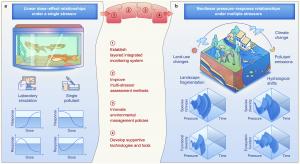Tipping the balance: how hidden chemical threats are reshaping ecosystems
GA, UNITED STATES, July 11, 2025 /EINPresswire.com/ -- Since the onset of the Anthropocene, chemical pollution has become a major global threat to biodiversity across all ecosystems. It is no longer a problem of simple cause and effect. A new study reveals that pollutants can trigger sudden and dramatic ecological changes, acting like hidden levers that push ecosystems past points of no return. These shifts often happen without warning—disrupting biodiversity, altering food webs, and weakening natural resilience. Rather than following a predictable pattern, the impact of chemical contaminants often unfolds through complex, nonlinear dynamics. To tackle this, researchers propose an integrated framework that blends real-time monitoring with predictive modeling, offering a sharper lens to detect early warning signs and prevent irreversible damage. This approach could transform how we safeguard global ecosystems in the face of escalating environmental stress.
For decades, environmental regulations have relied on the idea that pollution harms nature in a steady, measurable way: more pollution equals more damage. But ecosystems are not that simple. Even low doses of chemicals can quietly disrupt metabolism, reproduction, and behavior, weakening species long before populations visibly decline. As pollution levels increase, the effects can suddenly accelerate, leading to cascading consequences across habitats and species. These tipping points are further magnified when chemical stressors interact with other global threats like climate change and habitat loss. Due to these complexities, there is an urgent need to move beyond linear assumptions and develop ecological risk models that reflect the real-world dynamics of pollution.
A cross-institutional team of researchers from the Chinese Research Academy of Environmental Sciences, Beijing Normal University, China National Environmental Monitoring Centre, Chinese Academy of Sciences, Yunnan University, and the UK Centre for Ecology and Hydrology has developed a bold new model for understanding chemical pollution. Published on June 25, 2025, in Environmental Science and Ecotechnology, the study outlines a shift away from traditional risk assessments. It introduces a dynamic framework that captures how chemical pollutants interact with other environmental stressors to trigger nonlinear, often unpredictable impacts on biodiversity across land, freshwater, and marine ecosystems.
The proposed framework consists of four interlocking components designed to anticipate and respond to the complex, nonlinear effects of chemical pollutants under multiple environmental stressors. First, a hierarchically structured monitoring system integrates chemical, biological, and ecological data across ecosystems using cutting-edge tools like environmental DNA metabarcoding and non-target chemical screening. In practice, such methods have successfully traced pollution sources in complex mixtures, such as in Guangzhou's Chebei Stream. Second, the framework introduces advanced analytics—such as mixture toxicity testing and machine learning—to identify when ecosystems are approaching a critical tipping point. Third, the authors advocate for integrating multi-stressor monitoring frameworks into environmental regulations. The European Union's REACH program presents a strategic opportunity to incorporate real-time, nonlinear risk assessments into chemical safety decisions. Finally, the study emphasizes the importance of scalable technology: smart biosensors and satellite-based vegetation monitoring offer timely insights into ecosystem stress and recovery. For example, satellite data from the Amazon Basin revealed slower vegetation recovery after droughts—an early signal of ecological decline. Together, these components form a proactive system capable of detecting emerging threats and supporting adaptive ecosystem management before irreversible damage occurs.
"Our current models are too simplistic to capture how real ecosystems respond to pollution," explains Dr. Xiaowei Jin, corresponding author and senior researcher at the China National Environmental Monitoring Centre. "Chemical pollutants don't act alone—they interact with climate shifts, habitat loss, and species dynamics. By integrating high-resolution monitoring with predictive analytics, we can spot danger before collapse occurs. This new framework marks a vital turning point for environmental policy—one that better matches the complexity of the world we live in."
This nonlinear framework could revolutionize how policymakers and scientists approach environmental risk. By recognizing and quantifying complex pollutant interactions, the system allows for earlier, more accurate identification of ecological tipping points. Regulators can use this knowledge to revise pollutant thresholds, prioritize sensitive regions, and implement timely interventions tailored to local ecological contexts. The model also encourages transdisciplinary collaboration—uniting ecologists, data scientists, and policy experts to safeguard biodiversity in a rapidly changing world. As global pressures mount, this approach provides a science-based, adaptive roadmap to better protect ecosystems and the life they support.
References
DOI
10.1016/j.ese.2025.100589
Original Source URL
https://doi.org/10.1016/j.ese.2025.100589
Funding information
This work was funded by the National Natural Science Foundation of China (42322710, 42477299) and the National Science Fund for Distinguished Young Scholars (42325706).
Lucy Wang
BioDesign Research
email us here
Legal Disclaimer:
EIN Presswire provides this news content "as is" without warranty of any kind. We do not accept any responsibility or liability for the accuracy, content, images, videos, licenses, completeness, legality, or reliability of the information contained in this article. If you have any complaints or copyright issues related to this article, kindly contact the author above.
